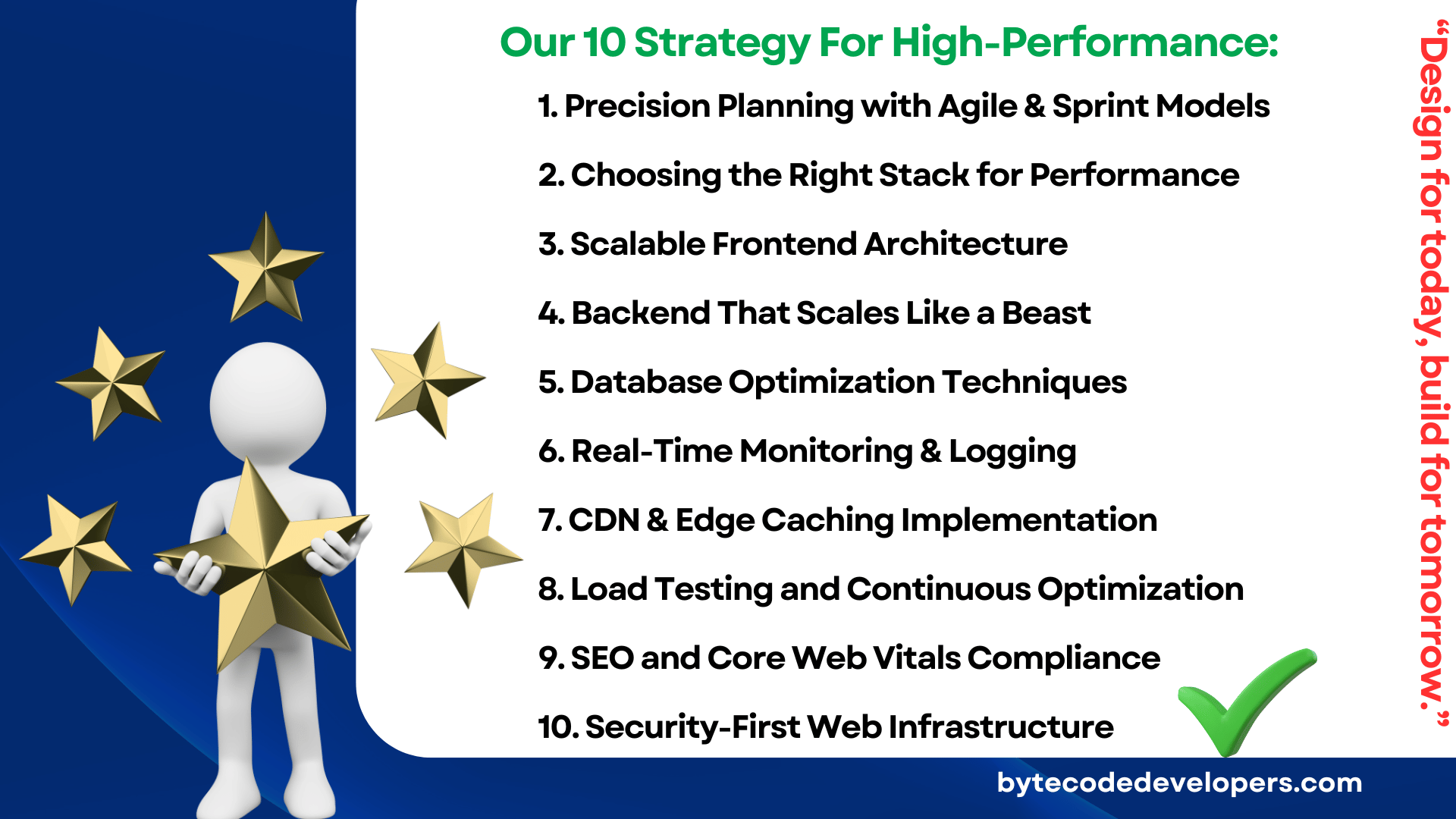
Table of Contents
In today’s digital age, scalability and performance are non-negotiables. Whether you're running a startup or a full-blown enterprise, your website is your frontline soldier. At Byte Code Developers, we don’t just build websites we engineer digital powerhouses designed to scale effortlessly and perform flawlessly under pressure. Here's a deep dive into how we do it.
Why Website Scalability Matters in 2025
The web isn't what it was five years ago. With traffic surges, AI integrations, real-time user experiences, and global audiences, your website needs to hold up.
- User Retention: A scalable site handles spikes without downtime.
- Conversion Rate: Faster websites = better sales.
- SEO Boost: Google loves fast, responsive websites.
- Long-Term Cost Efficiency: Build it right once, scale forever.
A slow or unstable site is a dealbreaker in 2025 for both users and search engines.
Byte Code Developers’ Philosophy: Build Smart, Scale Hard
Our approach isn’t “one-size-fits-all.” Every website we touch is treated like a custom engineering challenge. Our mantra:
“Design for today, build for tomorrow.”
This means:
- Every line of code is performance-checked.
- Every architecture is future-proof.
- Every deployment is ready for global scale.

Step 1: Precision Planning with Agile & Sprint Models
Before any code is written, we blueprint everything. Our Agile-first development process ensures flexibility, clarity, and momentum.
- User Story Mapping: To break down complex features
- Sprint Backlogs: Prioritized tasks for speed
- Milestone Tracking: Keep stakeholders in the loop
Planning is 80% of the work. Execution becomes seamless after that.
Step 2: Choosing the Right Stack for Performance
We’re stack-agnostic but performance-obsessed. Here's what we often use:
- Laravel APIs, admin panels
- Node.js Real-time apps, microservices
- Next.js + React Ultra-fast frontend
- PostgreSQL Complex relational data
- Redis Caching, queues
- Docker Environment consistency
- Tailwind CSS Lightweight styling
We always select based on your business needs, not what's trendy.
Step 3: Scalable Frontend Architecture
Frontend isn’t just UI it’s UX, SEO, and load time all rolled into one.
We implement:
- Code Splitting: Load only what’s needed
- Lazy Loading: Defer offscreen assets
- SSR (Server-Side Rendering) with Next.js
- Global State Management using Redux or Zustand
By modularizing components, our frontends load faster and scale cleaner.
Step 4: Backend That Scales Like a Beast
Heavy lifting happens at the backend. Ours are built like tanks but sprint like cheetahs.
Our backend strategies:
- RESTful APIs & GraphQL APIs
- Horizontal Scalability with Docker Swarm or Kubernetes
- JWT-Based Auth & ACLs
- Asynchronous Job Queues for non-blocking tasks (e.g., emails, reports)
We bake scalability into the core logic not as an afterthought.
Step 5: Database Optimization Techniques
Databases are the spine of your app don’t let them break under pressure.
What we do:
- Use Indexes Wisely
- Connection Pooling
- Sharding & Replication for scaling reads/writes
- Stored Procedures for repetitive DB logic
- Backup + Disaster Recovery Plans
We benchmark queries constantly and auto-alert slow SQL in production.
Step 6: Real-Time Monitoring & Logging
If you can’t measure it, you can’t improve it.
We use tools like:
- Grafana + Prometheus
- New Relic / Datadog / Sentry
- ELK Stack (Elasticsearch, Logstash, Kibana)
This helps us catch bugs before they go live and gives you transparency.
Step 7: CDN & Edge Caching Implementation
- When milliseconds matter, CDNs step in.
- We use Cloudflare, Fastly, or AWS CloudFront
- Cache images, static files, and even entire pages
- Serve from edge locations near your user
Step 8: Load Testing and Continuous Optimization
We simulate real traffic scenarios using:
- k6 and Apache JMeter
- Lighthouse CI for ongoing Core Web Vitals audits
- Real-user monitoring (RUM)
We don’t ship until your site can handle 1000+ concurrent users with zero sweat.
Step 9: SEO and Core Web Vitals Compliance
We build Google-loving websites.Your site won’t just rank it’ll outrank.
Step 10: Security-First Web Infrastructure
We lock it down before bad actors knock.
Security features:
- HTTPS with auto-renewing SSLs
- WAF + DDoS Protection
- IP whitelisting for admin
- Rate limiting & anti-spam
- Secrets management via Vault or SSM
- Security is not a plugin — it's our default state.
- Power Tools We Use Daily
Success Stories of Our Clients
E-Commerce Platform: 400% traffic spike managed without downtime
Legal Firm Website: 90+ Google PageSpeed score
EdTech SaaS: Scaled from 50 to 10,000 users in under a year
We don’t just deliver. We overdeliver.
Frequently Asked Questions (FAQs)
1. What makes a website scalable?
A scalable site can handle increased traffic and data load without slowing down or crashing. It includes good backend architecture, database design, caching, and deployment strategies.
2. How do you improve website performance?
We optimize both frontend (minified JS, image compression) and backend (query optimization, job queues). CDN, caching, and lazy loading also help.
3. How fast is your average delivery time?
Depends on the scope, but our Agile sprints usually mean delivery within 4–6 weeks for full-scale projects.
4. Can you work with existing websites?
Yes. We often revamp, refactor, or scale existing codebases — without breaking them.
5. What is your pricing model?
We work on fixed-price or milestone-based billing. No surprises. Clear contracts.
6. Do you offer ongoing maintenance?
Absolutely. We provide 24/7 support and ongoing performance/security updates.
Let’s build your future-proof website today.




 March 26, 2025
March 26, 2025

-thumb.webp)








-thumb.webp)